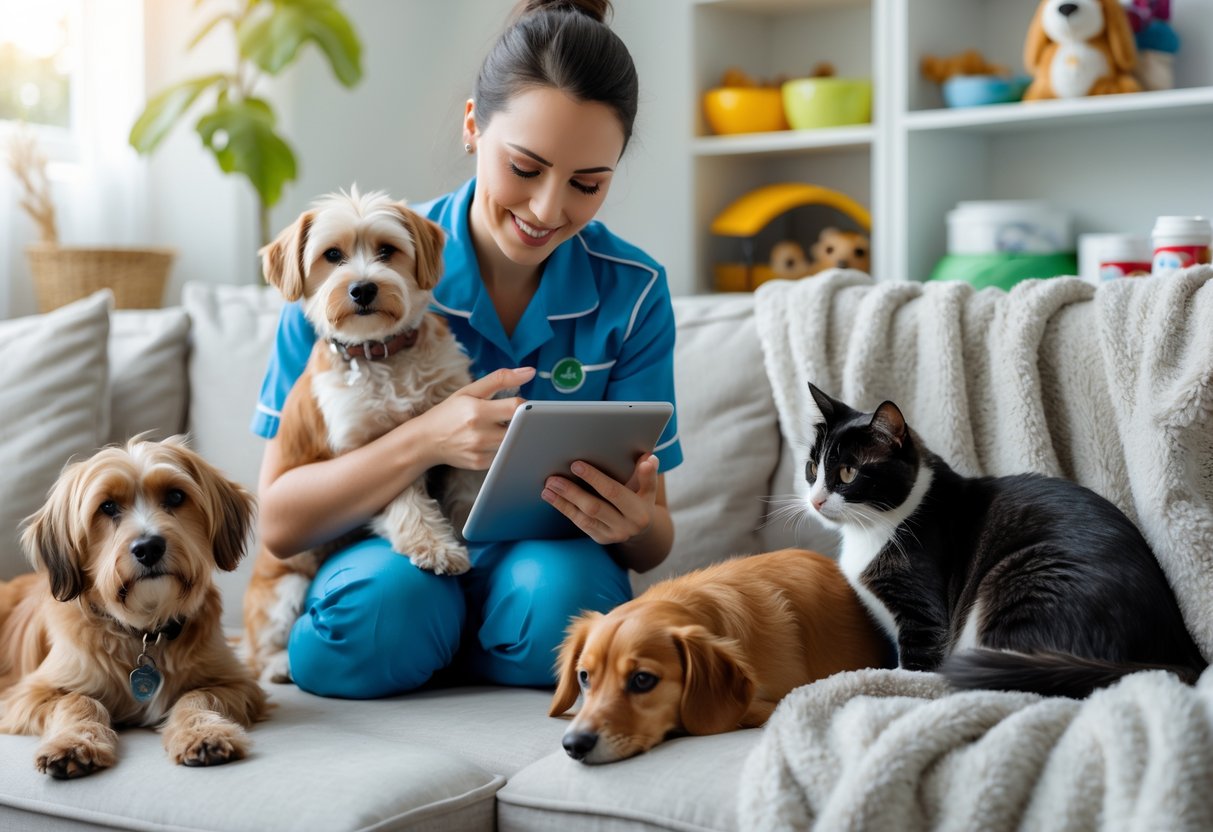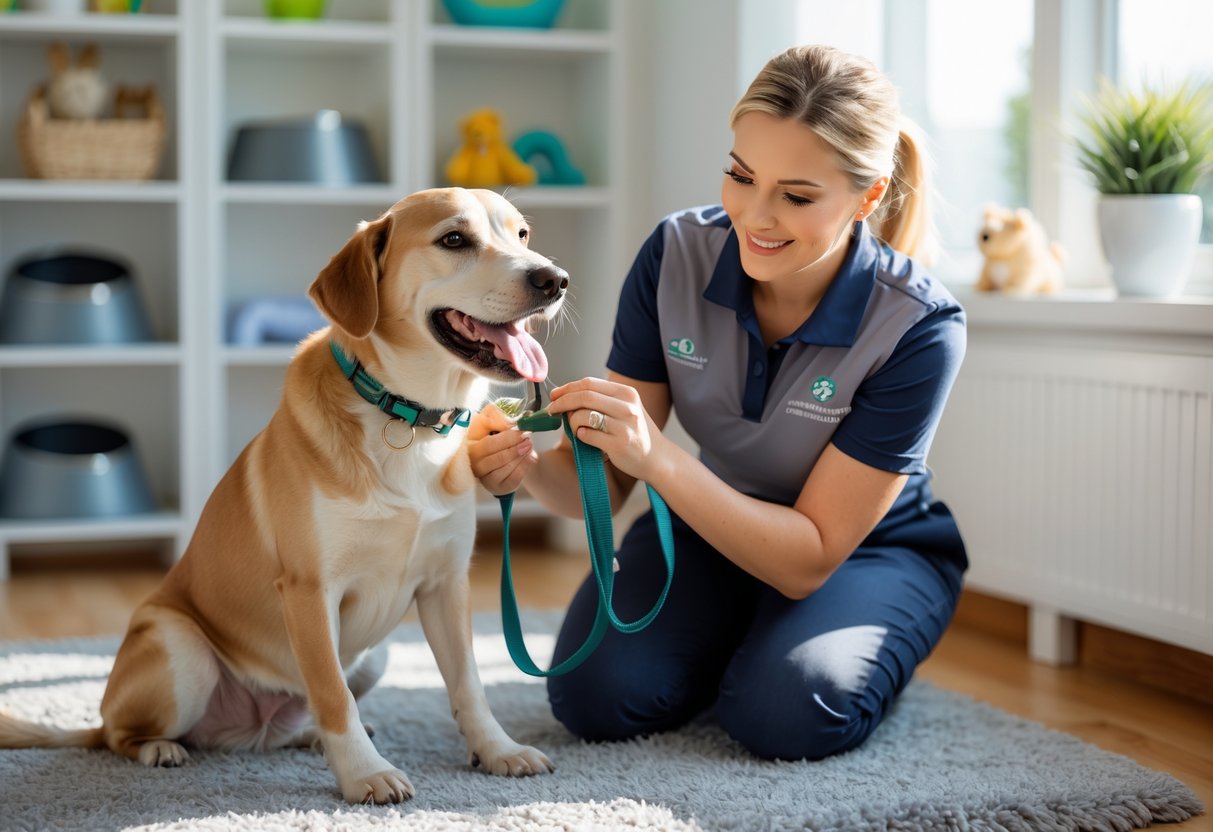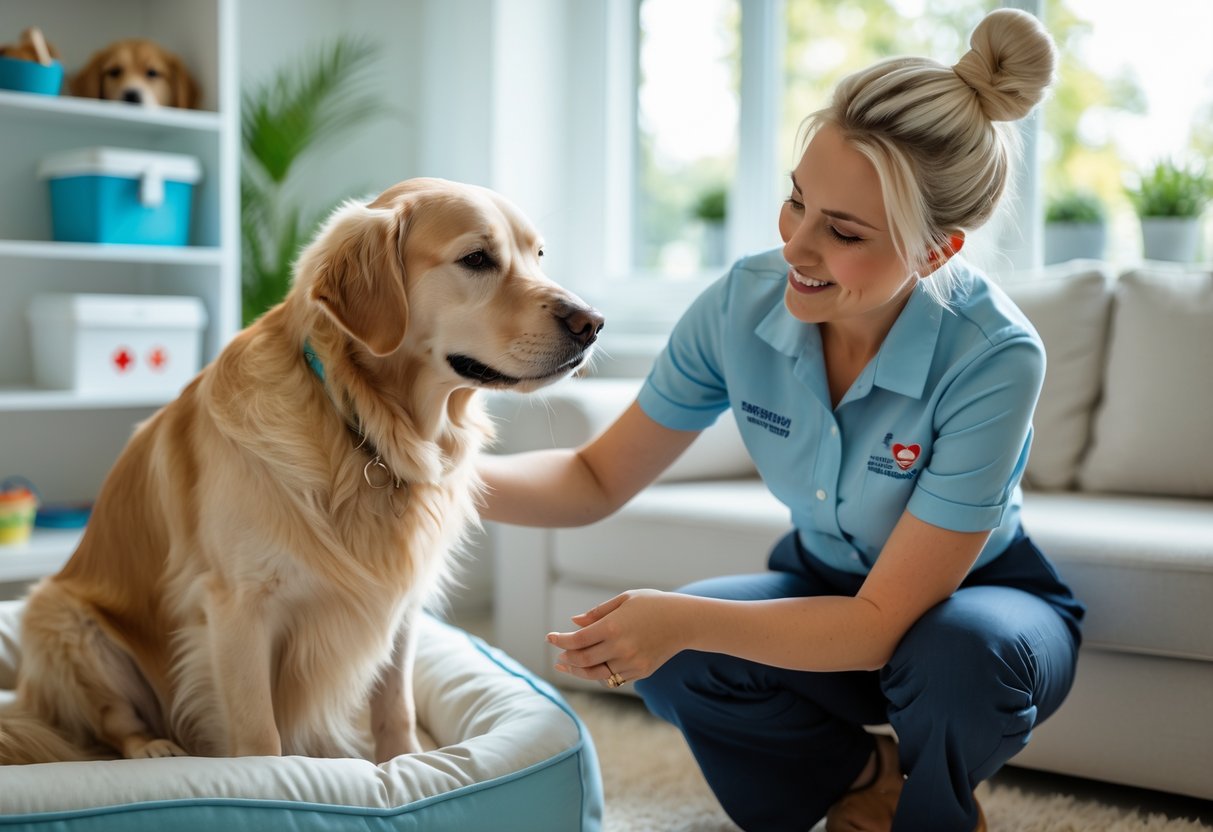Leaving your pet behind when you travel or work long hours is tough. You want to know your furry friend will be safe, happy, and cared for while you’re away.
That’s where professional pet sitting services come in. They offer peace of mind through trained care.

Professional pet sitters keep your pet safe by following established protocols. These include emergency preparedness, health monitoring, training in pet behaviour and first aid, and consistent communication with you.
Professional pet sitting services maintain your pet’s safety through experience, preparation, and dedication to your pet’s unique needs.
Knowing what professional sitters actually do can help you choose the right care. Qualified pet sitters create emergency plans and watch for signs of illness, taking steps to keep your companion safe and comfortable.
Key Takeaways
- Professional pet sitters use emergency contacts, health monitoring, and proper training to keep your pet safe
- Good pet sitters maintain regular communication with you and follow established care routines for your pet’s comfort
- Experienced sitters know how to handle extreme weather, prevent injuries, and respond quickly to emergencies
How Professional Pet Sitters Safeguard Your Pet’s Safety and Well-Being
Professional pet sitters follow strict protocols to protect your pet. They use careful screening, detailed pre-service consultations, and proven methods for a secure home environment.
These practices help ensure your furry friend receives consistent, safe care while you’re away.
Rigorous Pet Sitter Selection and Training
When you hire a professional pet sitter, you’re trusting them with your pet’s life. Reputable pet sitting services get that and screen their sitters thoroughly.
Professional pet sitters need real experience and training in caring for pets, including pet behaviour, first aid, and care protocols. Most legitimate services run background checks to make sure sitters have a clean criminal history.
Many companies also check professional references and hold multiple interviews before hiring. Training doesn’t stop after they’re hired.
The best pet sitters complete pet first aid and CPR certification. They learn safe leash handling and how to read animal body language, so they can spot when your pet feels stressed or unwell.
Professional organisations like Pet Sitters International offer ongoing education, so sitters stay current with industry standards and best practices. Your pet sitter should carry proper insurance too—general liability and care, custody, or control coverage that protects your pet and your property.
The Power of the Meet and Greet
The meet and greet lays the foundation for safe, personalised pet care. During this first visit, your pet sitter comes to your home before any paid services begin.
This visit lets the sitter meet your pet in their own space and see their normal behaviour. You’ll discuss your pet’s routine, diet, medication, and quirks.
Your sitter writes down all these details in a comprehensive pet profile that guides every visit. The meet and greet is also when you show your sitter where you keep food, leads, and cleaning products.
You’ll share important info like your vet’s contact and emergency procedures. Many professional pet sitters provide detailed onboarding that gathers medical history and emergency contacts during this session.
This face-to-face meeting helps your pet get comfortable with their new caregiver. It also gives you a chance to see if the sitter seems responsible and capable.
Both you and the sitter can ask questions and talk through any concerns, making sure everyone feels good about the arrangement.
Creating a Safe and Nurturing In-Home Environment
In-home pet sitting keeps your pet in familiar surroundings. This reduces stress and helps them stick to their normal routine.
Professional pet sitters follow your pet’s schedule for feeding, walks, playtime, and rest. This consistency makes your pet feel calm and secure.
They watch closely for signs of stress, illness, or injury and contact you or your vet if needed. Security matters, too.
Reputable sitters store your keys and alarm codes securely. They never share info about your absence with unauthorised people.
They make your home look occupied by varying arrival times and bringing in post or packages. Professional pet sitters also practise biosecurity.
They wash their hands between visits and sanitise equipment to prevent disease spread. If your pet needs medication, your sitter gives it as your vet instructs and records each dose.
Best Practices for Ensuring Pet Comfort, Communication, and Emergency Response
Professional pet sitters use specific practices to keep your pets comfortable. They maintain open dialogue with you and handle unexpected situations.
These strategies create a safe environment and give you peace of mind while you’re away.
Maintaining Consistent Daily Care and Emotional Support
Your pet thrives on routine. Professional pet sitters know this and keep feeding schedules, exercise, and playtime close to your pet’s normal day.
This consistency helps reduce anxiety and keeps your furry friend feeling secure. Quality pet care goes beyond physical needs—it includes emotional support.
Pet sitters spend time bonding with your pet through activities they enjoy—cuddle sessions, interactive play, or just hanging out nearby. They watch for stress signs like cowering, panting, or changes in eating habits.
Key comfort measures include:
- Respecting your pet’s boundaries and space
- Never disturbing animals while they’re eating
- Providing treats and enrichment activities
- Letting pets approach at their own pace
Professional sitters adjust their approach based on each pet’s personality. Some animals need more attention and reassurance, while others like independence.
By observing your pet’s body language, sitters can tweak their interaction style. It’s not always easy, but a good sitter pays attention.
Clear Communication With Pet Owners
Regular communication between pet sitters and pet owners builds trust and ensures quality care. Professional services send updates by your preferred method—text, photos, or written reports.
You should get info about your pet’s meals, bathroom breaks, behaviour, and activities. Many sitters send photos or videos of your pet having fun.
This transparency helps you relax, knowing your companion is in good hands. Before services start, sitters ask about your pet’s needs, preferences, and medical history.
They’ll want to know feeding instructions, medication schedules, favourite toys, and quirks. This thorough intake process prevents confusion and allows for personalised care.
Essential communication elements:
- Emergency contact info for you and your vet
- Daily care updates with real details
- Immediate notification of any concerns
- Open availability for your questions
Effective sitters adapt their communication style to match your preferences. You get the right amount of info at times that work for you—no more, no less.
Staying Prepared: Pet First Aid and Emergency Protocols
Professional pet sitters show up with emergency supplies and protocols for the unexpected. They carry a kit with hand sanitiser, spare leads, waste bags, bottled water, pet food, treats, and a basic first aid kit.
Having these essentials means they can handle minor incidents fast. Sitters keep their phone charged at all times to reach emergency services or your vet if needed.
They learn about your pet’s medical conditions and know where to find carriers, extra leads, and meds. This prep pays off during stressful moments.
Understanding signs of pet distress helps sitters act quickly:
- Overheating: drooling, panting, discoloured gums, tremors
- Hypothermia: rapid breathing, lethargy, pale gums, cold to touch
- General emergencies: vomiting, collapse, trouble breathing
Pet emergency preparedness includes planning for natural disasters. Sitters know evacuation routes and have a plan for your pet’s safety during severe weather.
They keep emergency contact lists handy, including your vet and local animal hospitals. Professional services train staff in pet first aid and CPR, so they can give immediate care while seeking veterinary help.
Frequently Asked Questions
Pet owners have plenty of questions about how their animals will be cared for when they’re gone. Professional pet sitters use specific practices to protect your pet’s health, happiness, and security through training, clear communication, and personalised attention.
What measures do pet sitters take to create a safe and comforting environment for your furry friends?
Professional pet sitters keep your home secure by managing house keys and locking all entry points when they leave. They maintain your pet’s familiar surroundings and daily routines to reduce stress.
Pet sitters watch for signs of fear or aggression to prevent injuries. They never disturb pets while they’re eating—even calm dogs can get possessive with food.
Your sitter keeps their phone charged and ready in case of emergencies. They’ll also look after their own belongings and won’t leave items behind in your home.
How does a professional pet care service handle emergency situations to keep your beloved companions secure?
Pet sitters keep emergency contact lists handy while you’re away. These lists include your details, your main vet, local relatives, and even a neighbour or two.
They save this info on their phones so they can reach someone fast if things go sideways. No one wants to scramble for numbers in a crisis.
Most pros carry emergency supplies. We’re talking hand sanitiser, treats, bottled water, pet food, a spare lead, waste bags, a towel, and a basic first-aid kit.
They’ll also bring any meds your pet might need—just in case.
Your sitter knows how to spot signs of overheating, like heavy panting, drooling, weird gum colour, or tremors. On cold days, they’ll watch for hypothermia—rapid breathing, sluggishness, pale gums.
If a sitter arrives and something looks off—a break-in, maybe—they get out of there and call the police. You’ll hear from them right after.
In what ways do pet sitting providers tailor their care to match each individual pet’s needs and routines?
Pet sitters tweak their approach to fit your pet’s quirks and routines. They’ll stick to your feeding schedule and favourite playtimes because consistency matters.
Before starting, your sitter will ask about your pet’s temperament, habits, and any special needs. They’ll also check notes from past sitters to get a sense of what works.
They adjust care based on breed and personality. For instance, hairless cats or those squishy-faced dogs? They get extra attention when it’s hot out.
Could you tell us about the kind of training and qualifications a professional pet sitter should have to ensure top-notch welfare for your pets?
Good pet sitters usually have solid experience with animals—sometimes even a specialty, like exotics, big dogs, or tiny critters. Many sitters focus on certain animals and know the ins and outs of their care.
Your sitter really should understand animal body language and behaviour. That way, they can spot when your pet’s stressed, scared, or feeling off.
They know how to handle medical emergencies and give medication if needed. Hygiene’s a big deal too—they wash hands often or use sanitiser between visits.
What steps are taken by pet sitters to maintain constant communication with you about your pet’s status during your absence?
Pro sitters keep their phones charged and close by, so you can always reach them. They send regular updates about meals, walks, and how your pet’s feeling.
If anything seems off—health, mood, whatever—they’ll let you know right away. Some even snap photos of emergency info so it’s always at their fingertips.
Pet sitting services stay organised with communication so you feel reassured. They’ll answer your questions quickly and keep you in the loop until you get home.
How do pet sitting services go above and beyond to make sure your pets receive the best possible love and attention while you’re away?
Pet sitters spend real time playing with your animals. They actually hang out with your pets, offering companionship that goes way beyond just feeding or walking them.
They don’t just tick off a checklist—they connect with your pets to help ease loneliness and those anxious moments.
Your sitter will stick to well-lit areas when walking dogs after dark. They keep an eye on their surroundings, always thinking about safety first.
When the weather gets wild, sitters take extra steps to keep your pets safe from heat or cold. No one wants a shivering or overheated pup.
Professional sitters often bring treats and backup supplies, just in case. They clean litter boxes, refill water bowls, and tidy up so your pet feels comfortable at home.




